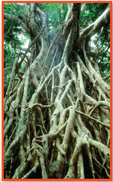Most water transport in stems takes place in
heartwood.
pith.
phloem.
sapwood.
From what type of tissue does bark develop?
What is the primary difference between monocot and dicot stems?
Think Critically
Infer If your classmate gave you a slide showing a cross section of a dicot, how would you know whether it was from a root or a stem?
Design an Experiment What relationship would you expect between a plant's life span and its ability to undergo secondary growth? What data could you collect? Describe an experiment to collect the data.
Apply Concepts In the art of bonsai, gardeners keep trees small by cutting the roots and tips of the branches. The trunk of the tree, however, continues to increase in width. How do you explain the ever-increasing width of the trunk?
23.4 Leaves
Understand Key Concepts
Most of the photosynthetic activity of a leaf takes place in the
vascular bundles.
waxy cuticle and epidermis.
palisade and spongy mesophyll.
guard cells and stomata.
Stomata open and close in response to water pressure within
root cells.
cell walls.
guard cells.
xylem.
What is the function of the epidermis and cuticle layers in a leaf?
What needs of the plant are met by controlling the opening and closing of stomata?
Think Critically
Compare and Contrast Compare the ways in which a cactus and a conifer are adapted to their respective biomes.
Relate Cause and Effect A plant's stomata are open early on a summer day when the air is cool and moist. By afternoon, when the air is hot and dry, the stomata are closed. Explain this observation.
solve the CHAPTER MYSTERY

THE HOLLOW TREE
The life of a strangler fig starts with a sticky seed deposited on a high tree branch by an animal such as a bird, bat, or monkey. At first, growth is slow because the roots have access only to the few dissolved nutrients found in the rainwater and leaf litter that collect in the crevices of the host's branches. But, after the first roots grow down the host's trunk and enter the ground, the fig's growth rate increases rapidly. The fig sends down many more roots. These roots become tangled and grafted together, crushing the host's bark and constricting the circulation of nutrients inside the phloem.
In addition, the fig's stems and leaves eventually grow taller than the host, shading it from the sun. This makes photosynthesis by the host less efficient. Below ground, the fig's roots compete with the host's roots for limited nutrients in the soil.
This triple punch—strangulation, competition for light, and competition for nutrients—usually kills the host. Left behind is an impressive “hollow” fig tree.
Use Analogies One scientist has described the strangler fig as a “vegetable octopus.” Explain how this analogy relates to the habits of the strangler fig.
Predict Plants that sprout and grow on top of other plants are called epiphytes. In what biome do you think epiphytes are most common? Explain your prediction.
Connect to the
 How is the structure of the strangler fig different from that of the “typical plant” you studied in this chapter? Compare the advantages and disadvantages of a rain-forest plant that sprouts in the soil versus one that sprouts high off the ground.
How is the structure of the strangler fig different from that of the “typical plant” you studied in this chapter? Compare the advantages and disadvantages of a rain-forest plant that sprouts in the soil versus one that sprouts high off the ground.

Table of Contents
- Formulas and Equations
- Applying Formulas and Equations
- Mean, Median, and Mode
- Estimation
- Using Measurements in Calculations
- Effects of Measurement Errors
- Accuracy
- Precision
- Comparing Accuracy and Precision
- Significant Figures
- Calculating With Significant Figures
- Scientific Notation
- Calculating With Scientific Notation
- Dimensional Analysis
- Applying Dimensional Analysis




